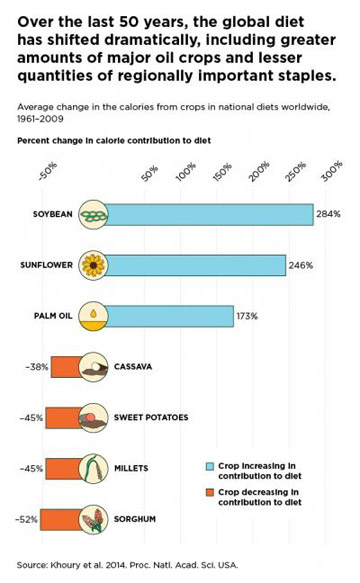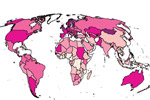A new study published in the Proceedings of the National Academy of Sciences (PNAS) points to the homogenization of global diets over the past fifty years. It shows that worldwide production of traditional staples such as millet, rye, sorghum, yams and cassava have been in decline. Instead, the world’s population increasingly relies on a relatively small number of “megacrops” like wheat, corn and soy, raising serious concerns for global food security, human nutrition, and the genetic diversity of crops.
In terms of their growing contribution of calories to global diets since the 1960s, two crops that stand out are soybeans and palm
oil. The sudden rise of soy and palm oil underlines just how central dietary changes have been in driving tropical deforestation.
Brazil is the world’s second largest producer and exporter of soybeans, and the crop has become an increasingly central threat to
biodiversity and forest cover in the southern Amazon. Much of the demand for soybeans is related to its role as feed for livestock,
another major threat to forests in Brazil and elsewhere.
 |
Across the world in Indonesia and Malaysia, oil palm plantations have replaced tropical forests on a massive scale since the 1990s. This has increased greenhouse gas emissions and destroyed the habitats of orangutan and many other endangered species. Severe haze in Southeast Asia linked to expanding palm oil production has impacted human health and made international headlines.
Local and international efforts have succeeded in raising awareness of these problems. Environmentally-conscious consumers are increasingly wary of consuming soy and palm oil products. A long and growing list of companies have therefore made commitments to using certified sustainable palm and soy products, while plantation companies are pledging not to contribute to deforestation. Improving environmental practices in soybean and palm oil production is welcome and should continue.
However, the long-term trend in global diets, rising human populations, and climate change show that such efforts may not be enough. As long as the consumption of globally-sourced vegetable oils and animal products continues to climb, the economic pressure on
tropical forests will increase as a result. Diversified, locally-oriented food systems are ultimately the only sustainable
option.
CITATION: Colin K. Khourya,b,1, Anne D. Bjorkmanc,d, Hannes Dempewolfd,e,f, Julian Ramirez-Villegasa,g,h, Luigi Guarinof, Andy Jarvisa,g, Loren H. Riesebergd,e,i, and Paul C. Struikb. Increasing homogeneity in global food supplies and the implications for food security. PNAS, 2014 DOI: 10.1073/pnas.1313490111
Related articles
20 million people face hunger in Africa’s Sahel region
(02/04/2014) The UN and partner humanitarian groups today called on the international community to spend $2 billion to avoid a famine in Africa’s Sahel region, which includes nine nations along the southern edge of the Sahara. Although the Sahel is chronically prone to food insecurity, the situation has dramatically worsened as the UN estimates 20 million people are at risk of hunger up from 11 million last year.
Chickens before cows: new study finds cattle have outsized greenhouse gas footprint
(12/19/2013) If you want to lower your greenhouse gas emissions, choose chicken or poultry over beef and dairy, according to a massive new study in the Proceedings of the National Academy of Sciences (PNAS). The study finds that global cattle production—both for beef and dairy—is responsible for a whopping 77 percent of the world’s greenhouse gases attributed to livestock. Meanwhile, pork and poultry account for only 10 percent the greenhouse gases from livestock.
Humans are not apex predators, but meat-eating on the rise worldwide

(12/05/2013) A new paper in Proceedings of the National Academy of Sciences has measured the “trophic level” of human beings for the first time. Falling between 1 and 5.5, trophic levels refer to where species fit on the food chain. Apex predators like tigers and sharks are given a 5.5 on trophic scale since they survive almost entirely on consuming meat, while plants and phytoplankton, which make their own food, are at the bottom of the scale. Humans, according to the new paper, currently fall in the middle: 2.21. However, rising meat-eating in countries like China, India, and Brazil is pushing our trophic level higher with massive environmental impacts.
Scientists’ beef with land use decisions

(11/25/2013) When food goes to the garbage can instead of someone’s stomach, it is easy to see a wasted opportunity. The resources used to grow and transport that apple or hamburger went to the landfill. The Union of Concerned Scientists (UCS) is bringing another, less visible, form of food waste to the table, the waste created by eating foods that are inefficient to produce, like beef.